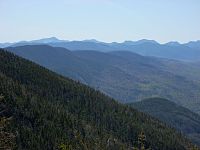
Photo from wikipedia
There has been an increasing interest in fodder trees and their potential to help the rural poor. However, few studies have addressed the ecological impacts of fodder tree harvesting. We… Click to show full abstract
There has been an increasing interest in fodder trees and their potential to help the rural poor. However, few studies have addressed the ecological impacts of fodder tree harvesting. We investigated the species harvested and the techniques used, and the effects of fodder harvesting on (1) species’ populations and (2) forest carbon stocks in three montane forests in Kenya. Focus-group discussions were organized in 36 villages to determine which species were harvested and with which techniques. Field observations were made on vegetation plots: stem diameter, tree height, species and extent of harvest were recorded. Carbon stocks were calculated using an allometric equation with (1) observed height of harvested trees, and (2) potential height estimated with a power model, and results were compared. Eight tree species were commonly harvested for fodder using different techniques (some branches, main stem, most branches except stem apex). Fodder harvesting (together with other uses for some species) negatively affected one species populations (Olea europaea), it did not negatively affect four (Drypetes gerrardii, Gymnosporia heterophylla, Pavetta gardeniifolia, Xymalos monospora), and more information is needed for three species (Olea capensis, Prunus africana, Rinorea convallarioides). Fodder harvesting did not significantly reduce forest carbon stocks, suggesting that local communities could continue using these fodder trees if a carbon project is established. Among the fodder species studied, X. monospora could be used in reforestation programs, as it has multiple uses and can withstand severe pruning. Although our study is only a snapshot, it is a baseline which can be used to monitor changes in fodder harvesting and its impacts related to increasing droughts in northern Kenya and increasing human populations.
Journal Title: New Forests
Year Published: 2018
Link to full text (if available)
Share on Social Media: Sign Up to like & get
recommendations!